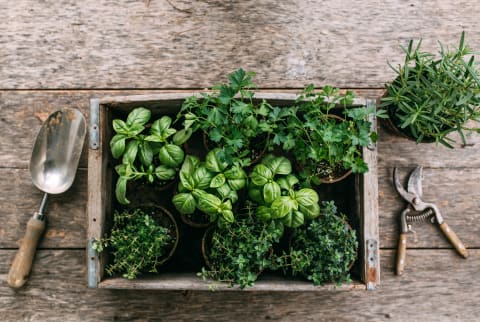Advertisement
How To Grow Your Own Food If You Don't Have A Garden

Maybe you don’t have a yard. Or your homeowners’ association restricts what you can do. Or you just don’t have the ability to build a chicken coop right now. Regardless of your situation or roadblocks there are plenty of ways to upgrade your pantry so you can start eating better-tasting—and nourishing—food. Think outside the box (and the grocery store) with some of these ideas.
Grow indoors
Indoor growing efforts can extend far beyond herbs—no greenhouse required. With a few considerations and some sunny windows, there are plenty of edibles that can be grown inside, including lettuce, kale, mushrooms, tomatoes, scallions, and even some dwarf fruit trees!
Visit the farmers market
There’s no better place to connect with your local foods movement than a farmers market. Browse locally grown vegetables, fruits, meats, and more and support small farms in the process. Plus it’s just plain fun to walk through a market with a basket on your arm and soak in the atmosphere.
Join a CSA
Community-Supported Agriculture programs, also known as CSAs, are a fantastic way to bring farm ingredients to your table. Even with our large garden, I still participate in them occasionally to expand our vegetable options. CSAs allow members to purchase shares of vegetables, fruits, and sometimes other foods from local producers. Payments are made at the beginning of the year, and shares are delivered weekly or biweekly throughout the growing season. Your dollars go straight to local farmers, and you have the freshest ingredients possible—it’s a win for everyone. Participating in our local CSA also helped me break out of my vegetable rut and try greens and root vegetables I never would have prior to joining.
Rent, lease, or share
Do you have friends or family with vacant garden plots or pastures? Who do you know who might want to partner on a food-growing adventure? Perhaps you can bring the labor and they will provide the space. I’ve even heard of older farm couples searching for energetic younger folks to work their land for them. With a little strategy and ingenuity, the possibilities here are endless.
Use technology to your advantage
Our milk cow came from craigslist.org, and we’ve purchased tractors and chickens from Facebook groups. The Internet can be a fabulous tool for connecting with other homesteaders, finding local producers, and sourcing supplies. Many areas have local homesteading groups on social media, which can be wonderful for finding new likeminded friends and getting the scoop on the best local ingredients in your region. You can also check out localharvest.org to find markets, farms, CSAs, and producers in your area.
Volunteer with local producers
Research is great, but nothing beats hands-on experience. Sharpen your skills and learn new ones by volunteering to help at local farms. Not all farmers will be open to this, so respect people’s time and space—but it never hurts to ask. Good things come to those who are willing to get their hands dirty
Join (or start!) a community garden
Community gardens come in all shapes and sizes, but generally involve a group of people coming together to grow fruit and vegetables on a shared lot. I can't think of a better way to get your feet wet in the world of home food production than by gardening alongside a group of folks who love vegetables just as much as you do. Many community gardens also donate portions of their harvest to local food banks, so they're making a difference in more ways than one.